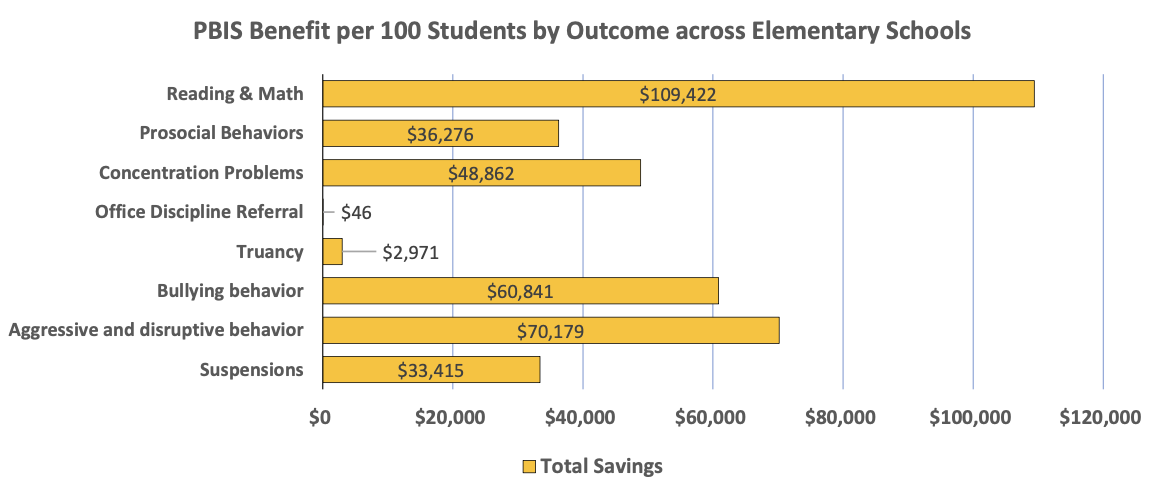Cost vs Benefit of PBIS
Money Talks
Ever wonder if PBIS is worth the time, effort, and expense? Spoiler: IT IS TOTALLY WORTH IT! Not just in qualitative benefits like improving school safety, climate, and learning environments - but in quantitative measures like cold, hard, cash.
One study found “a solid return on investment for PBIS, specifically, a net total cost savings in present value of $368,000 per 100 students in elementary school and $86,000 for students in secondary school.”
Another study found that “every $1 invested in PBIS resulted in a fiscal savings of $104.90, solely from reducing dropout by way of reducing suspension.
Google AI Response
We asked Google Scholar about the cost/benefits of PBIS - from a research and evidence point of view. Here is what we learned. References cited at bottom of page.
Research indicates that implementing Positive Behavioral Interventions and Supports (PBIS) can lead to significant cost savings and improved student outcomes, with studies showing reductions in office discipline referrals, suspensions, and potential dropout rates, as well as increased academic achievement and improved school climate.
Cost Savings:
Reduced Suspension and Dropout Rates:
PBIS can help reduce the need for suspensions and potentially lower dropout rates, leading to significant financial savings.
Lower Costs Compared to Other Interventions:
PBIS may be less expensive than other school-based prevention models or traditional dropout prevention programs.
Fiscal Savings:
One study found that for every dollar invested in PBIS, there was a fiscal savings of $104.90 from reducing suspensions and potential dropouts.
Reduced Staff Time:
PBIS can lead to savings in staff time, both administrative and instructional, by reducing the need for disciplinary interventions and individualized behavioral plans.
Reduced Costs of Mental Health Services:
By preventing behavioral and mental health symptoms, PBIS can potentially reduce the need for specialized services, leading to cost savings for education and other agencies.



Economic Benefits of PBIS: CalTech Keynote (2015)
Researchers: Bradshaw, Lindstrom-Johnson, Zhu & Pas
What are the Economic Benefits of Implementing PBIS (2017)
Researchers: Bradway, Lindstrom-Johnson, Bradshaw, McIntosh
Improved Student Outcomes:
Reduced Office Discipline Referrals:
PBIS can lead to a decrease in the number of office discipline referrals (ODRs), indicating improved student behavior.
Increased Academic Achievement:
Studies have shown that PBIS can lead to increased academic achievement and improved perceptions of school safety and organizational health.
Improved School Climate:
PBIS can contribute to a more positive and supportive school climate, benefiting both students and staff.
Improved Social-Emotional Learning:
PBIS can also help students develop social-emotional skills and improve their ability to regulate emotions.
Reduced Bullying:
PBIS can be effective in reducing bullying incidents and improving social-emotional functioning.
Implementation Costs:
Average Per-School Cost:
One study estimated the average per-school cost of PBIS at approximately $53,200.
Per-Pupil Cost:
The average per-pupil cost of PBIS was estimated at around $90, which is considerably less than other school-based prevention models.
Cost Variability:
The cost of PBIS implementation can vary depending on the level of fidelity and the specific evidence-based programs used within the tiered PBIS framework.
Importance of Fidelity:
High-fidelity implementation of PBIS tends to cost more, but also yields better outcomes.
Importance of Ongoing Training and Support:
Sustaining PBIS implementation requires ongoing training and support for staff.
Key Takeaways
PBIS is a cost-effective approach to improving student behavior and outcomes.
The benefits of PBIS extend beyond education, potentially benefiting federal and state agencies.
Implementing PBIS with high fidelity is crucial for maximizing its benefits.
Ongoing training and support are essential for sustaining PBIS implementation.
PBIS is a proactive approach that focuses on teaching and reinforcing positive behaviors rather than simply reacting to negative behaviors.
Google AI results from March 25, 2025

